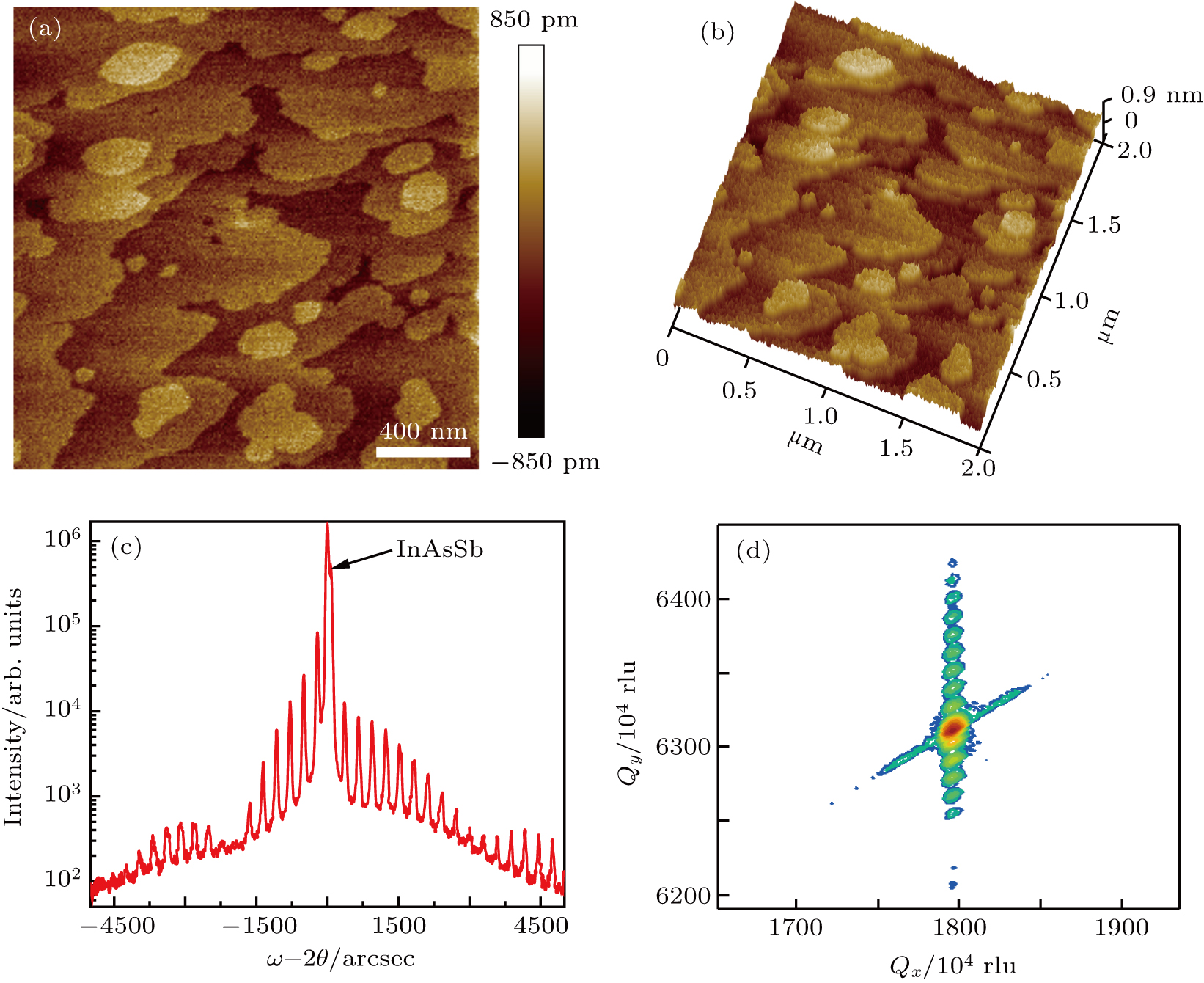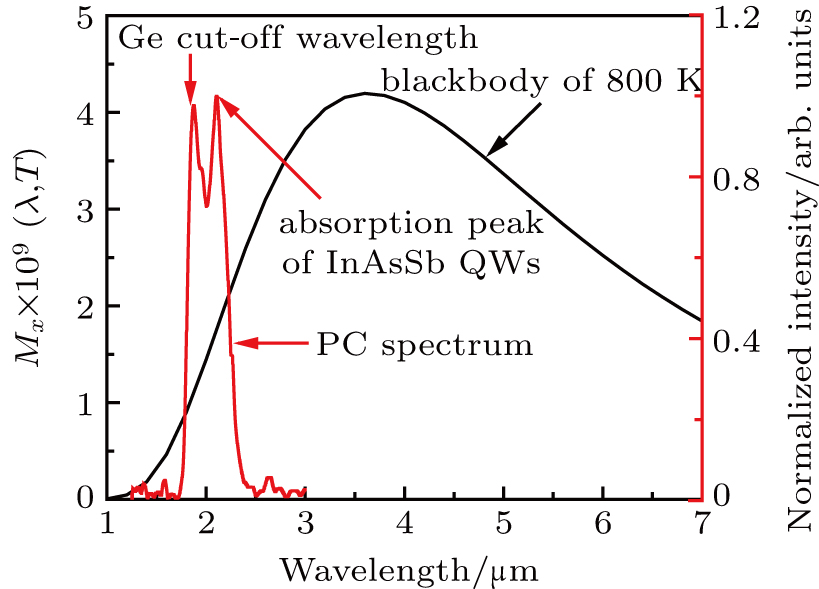† Corresponding author. E-mail:
Here in this paper, we report a room-temperature operating infrared photodetector based on the interband transition of an InAsSb/GaSb quantum well. The interband transition energy of 5-nm thick InAs0.91Sb0.09 embedded in the GaSb barrier is calculated to be 0.53 eV (




Research progress in infrared (IR) detector technology is mainly connected to the development of IR photodetectors, such as HgCdTe detectors, quantum well detectors, and superlattice detectors.[1–3] These detectors have been widely exploited in the fields of military surveillance, missile warning, guidance, etc.[4,5] The IR photodetectors exhibit a tunable and ultrafast response to the incident radiation with excellent signal-to-noise performance.[6] However, as the detection wavelength is longer, the narrower bandgap will result in increased thermal carriers, which significantly increase the dark current. In order to reduce the thermal noise, photodetectors require an exquisite cryogenic cooling system, which makes them bulky, expensive and have a short-life.[7,8]
Many efforts have been made to obtain photodetectors without the cryogenic cooling system operating in extended short-wavelength IR (eSWIR) and the mid wavelength IR (MWIR) ranges.[9–14] For example, p–i–n-type HgCdTe photodetectors operating at room temperature show high performances with suitable dopants,[13,15] while they require a complex material growth process and large area CdZnTe substrates are still unavailable.[16] Maimon and Wicks proposed a new type of barrier photodetectors,[17] such as InAsSb and HgCdTe nBn detectors,[18–20] which can reduce dark current and noise without an impeding photocurrent to increase the operating temperature. In addition, cascade IR detectors, such as interband cascade devices based on type-II InAs/GaSb interband supperlattice absorbers,[21] have been introduced to avoid the limitation imposed by reduced diffusion length and effectively increase the absorption efficiency.[22] However, the performances of the last two types still need to be improved compared with those of the traditional HgCdTe photodetectors. Therefore, it is needed to develop novel IR photodetectors with low cost, high performance and being capable of operating at room temperature.
In general, the operating temperature of the IR photodetector is determined by dark current, which mainly consists of diffusion current and generation–recombination (GR) current. Both the dark currents are proportional to the square of the intrinsic carrier concentration of semiconductor material, while the intrinsic carrier concentration is determined by a natural bandgap. So the balance between absorption wavelength and dark currents dominates the device design and intrinsic limit of the detector performance.[23] Recently, it has been reported that the photo-excited carriers in a low-dimensional semiconductor material can be effectively extracted from a p–n junction.[24–26] An InGaAs/GaAs quantum well (QW) prototype device based on such a phenomenon was already fabricated, which successfully proved the effectiveness of utilizing the interband transition of QWs as a new method of detecting IR spectra.[27] Because most of the device materials consist of wide bandgap barrier materials when using QWs, the dark current can be largely suppressed. Besides, based on the recently reported abnormal localized carrier extraction phenomenon, the absorption efficiency in thin QWs can be rather high, which can enhance the signal-to-noise ratio. So IR photodetectors based on the interband transition of QWs promise to achieve an effective high operating temperature in the IR detection.
As an ideal candidate material for fabricating the IR detectors, InAsSb can cover the wavelengths of MWIR and long-wave infrared (LWIR) with different antimony quantities.[28,29] Therefore, we here demonstrate a novel InAsSb/GaSb QW IR photodetector based on the interband transition. Such a detector has a working mechanism different from the currently widely used ones, which operate based on either inter sub-band transition of low-dimensional semiconductor materials, like GaAs/AlGaAs quantum well IR detectors, or interband transition of bulk material, like HgCdTe detectors. So it provides a new method to fabricate IR photodetectors operating at room temperature.
Since the energy level position is essential for designing an effective device, we first calculated the energy band structure of InAsSb/GaSb QW within the framework of effective-mass approximation as shown in Fig. 


Based on the principle of the interband transition of QWs and the calculation results, we designed the structure of the IR photodetector (Fig. 
After characterizing the crystal quality, the wafers were processed into a set of unpassivated mesa-isolated photodetectors with device area 1 mm2 by using the method of photolithography and wet etching. The electrodes of 20/100-nm Ti/Au were deposited onto the p-InAs in sequence by electron-beam evaporation. Then, 15/101/26/26/100-nm-thick Ni/Au/Ge/Ni/Au layers were deposited on the n-GaSb for an n-ohmic contact. The photodetectors were left unpassivated and had no anti-reflection coating. Then the sample was loaded into a cryostat with a germanium (Ge) window for both optical and electrical characterization. All the tests were carried out at room temperature except for the dark current.
Crystal quality of epitaxial layer directly determines the performance of the subsequent device. Figures 
The typical normalized relative spectral response curve is tested by a Bruker VERTEX 80 Fourier transform infrared spectrometer in Fig. 



The blackbody responsivity (Rbb) of the photodetector is measured using a blackbody signal test system. The 800-K blackbody emission spectrum is shown in Fig.
 |
Due to the narrow range of the spectral response of the photodetector and the deviation from the peak of the blackbody radiation at 800 K, the value of Rbb is obtained to be 9 mA/W under −500 mV applied bias voltage at an environmental temperature of 300 K. The peak responsivity (Rpeak) is calculated to be 0.4 A/W, corresponding to a quantum efficiency of 23.8% in the case without an anti-reflection coating. Since the total absorption thickness is 50 nm, the absorption coefficient is calculated to be 5.43×104 cm−1 under −500 mV applied bias voltage, which is one order of magnitude higher than that of the InAs/GaSb superlattice p–i–n photodetector.[30] Considering the mismatch between the responding wavelength and the blackbody spectrum, the Rbb can be further increased through arranging InAsSb QWs with different well thickness values and antimony composition to better fit the black body spectrum.
Dark current is one of the critical factors that determine the operating temperature of photodetector. Figure
The dark current characteristic of the sample shows an excellent performance at 300 K, but the measured results at variable temperatures are different. As seen in Fig.
As an important figure-of-merit of photodetectors, the Johnson noise limited detectivity 
 |


The InAsSb/GaSb QWs material system is chosen because of its peculiar type-II energy band structure and excellent limit to dark current. Besides, based on the theoretical calculation, the response range is tunable and it covers the eSWIR, MWIR and LWIR spectrum region with different antimony quantities and well widths. So it is very promising to fabricate the photodetectors covering 
In this work, we design, grow, and characterize the InAsSb/GaSb QW photodetectors based on interband transition. Through theoretical calculation, the transition energy of 5-nm thick InAs0.91Sb0.09 embedded in the GaSb barrier can be shortened to a value corresponding to a wavelength of 




We thank the Laboratory of Microfabrication, Institute of Physics, Chinese Academy of Sciences for fabricating the devices.
| 1 | |
| 2 | |
| 3 | |
| 4 | |
| 5 | |
| 6 | |
| 7 | |
| 8 | |
| 9 | |
| 10 | |
| 11 | |
| 12 | |
| 13 | |
| 14 | |
| 15 | |
| 16 | |
| 17 | |
| 18 | |
| 19 | |
| 20 | |
| 21 | |
| 22 | |
| 23 | |
| 24 | |
| 25 | |
| 26 | |
| 27 | |
| 28 | |
| 29 | |
| 30 | |
| 31 |









